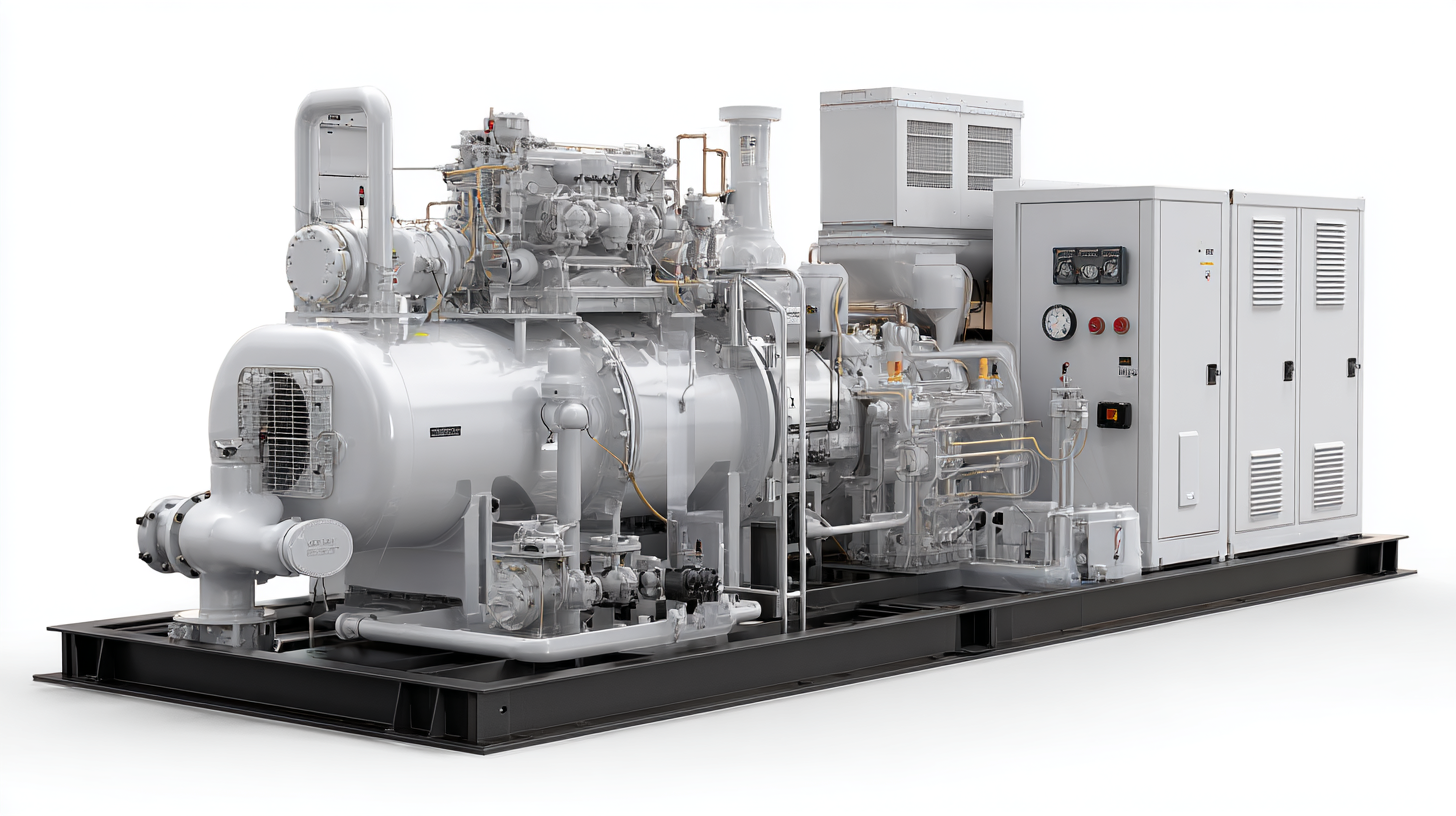
-
Home
-
About us
-
Products
-
Solutions
-
News
-
Blog
-
Contact us
Leave Your Message

The rising demand for clean energy solutions has led to significant advancements in hydrogen technology, particularly in the area of large-scale hydrogen production. The market for hydrogen liquefaction is projected to reach USD 4.83 billion by 2027, growing at a CAGR of 8.6% from 2020. Central to this growth is the development of Big Capacity Hydrogen Liquefiers, which are designed to optimize efficiency and reduce costs in hydrogen transportation and storage. These advanced liquefiers differ in design and operational mechanics, catering to a range of applications from industrial uses to energy storage solutions. Effective after-sales support and maintenance strategies can not only enhance the longevity and performance of these systems but also significantly impact total cost of ownership.

In this blog, we will explore the unique characteristics and applications of various scalable hydrogen liquefier models, coupled with best practices for post-sale support to maximize operational efficiency and reduce maintenance costs.
In the hydrogen liquefaction industry, effective after-sales support is crucial for maximizing the operational lifespan of large-capacity liquefiers and minimizing maintenance costs. Research indicates that proper maintenance programs can reduce downtime by up to 27% and enhance equipment reliability. For instance, according to the Hydrogen and Fuel Cell Technical Advisory Committee, investing in robust support systems can lead to a 15% reduction in operational costs over a five-year period.
Strategically implementing predictive maintenance practices can further lower expenses by providing timely interventions before equipment failure occurs. A study from the International Energy Agency highlights the potential for advanced analytics and IoT technologies to optimize maintenance schedules, which not only improves performance but also extends the lifetime of the equipment. Furthermore, establishing a comprehensive training program for operators can significantly improve their ability to troubleshoot and maintain liquefaction units, resulting in cost savings and enhanced performance, as demonstrated by companies that report a 20% increase in efficiency by prioritizing human capital in their after-sales support initiatives.
This chart represents the projected after-sales support and maintenance costs for hydrogen liquefaction units over a five-year period. The data shown includes projected costs in U.S. dollars for various service categories, helping stakeholders understand the financial implications of maintenance and support in the hydrogen liquefaction industry.
In the realm of large capacity hydrogen liquefaction, maximizing after-sales support and maintenance efficiency are crucial for minimizing operational costs. With the emergence of new technologies and innovative materials, businesses can enhance the performance of their systems without the need for costly upgrades. For instance, nanofluids have emerged as a quick and low-cost solution to boost system efficiency, allowing companies to maintain optimal operation while controlling expenses.
Furthermore, the adoption of predictive maintenance strategies powered by advanced technologies such as artificial intelligence has proven essential in improving equipment availability and efficiency. By focusing on proactive maintenance rather than reactive repairs, organizations can significantly reduce downtime and enhance productivity. This approach not only optimizes the maintenance cycle but also leads to improved asset management and resource utilization in large capacity systems like hydrogen liquefiers. Through efficient management practices and leveraging technological advancements, companies can achieve substantial cost savings while contributing to the sustainability transition in energy manufacturing.

In the rapidly evolving world of hydrogen liquefaction, companies must prioritize a customer-centric approach to enhance service experiences, particularly in after-sales support and maintenance. Understanding customer needs not only fosters loyalty but also drives operational efficiency. By placing the customer at the center of service strategies, businesses can tailor their support to address specific challenges faced by clients operating hydrogen liquefiers. This adaptability cultivates trust and encourages open communication, allowing for proactive solutions that anticipate issues before they escalate.

A key element of this customer-focused strategy is the development of comprehensive training programs for service personnel. Empowering staff with robust knowledge about both the equipment and customer operations ensures that they can provide relevant, timely assistance. Regular feedback loops with customers will also guide continuous improvement, enabling companies to refine their services based on real-world experiences. Employing this proactive, customer-centric approach transforms after-sales support from a reactive obligation into a dynamic relationship, ultimately leading to greater customer satisfaction and loyalty in the competitive hydrogen liquefaction market.
In the evolving landscape of hydrogen liquefaction, leveraging technology for predictive maintenance is paramount for maximizing after-sales support and managing maintenance costs. Predictive maintenance utilizes advanced algorithms and data analytics to monitor the condition of hydrogen liquefiers in real-time. By integrating IoT sensors and machine learning, operators can foresee potential failures before they occur, allowing for timely interventions that not only preserve equipment but also optimize operational efficiency.
The benefits of predictive maintenance extend beyond mere cost savings. By ensuring that hydrogen liquefiers operate at optimal performance, companies can enhance safety and reliability, critical factors in the hydrogen sector. Additionally, real-time monitoring can facilitate data-driven decision-making, empowering teams to fine-tune processes and reduce downtimes. As the demand for hydrogen energy continues to surge, investing in predictive maintenance technologies will be vital for manufacturers aiming to remain competitive while providing unparalleled after-sales support.
The advancement of hydrogen liquefaction technology presents immense potential for the energy transition, necessitating a focus on sustainable after-sales support practices. As noted in a recent report by McKinsey & Company, the global hydrogen market could reach up to $2.5 trillion by 2050, underscoring the need for robust maintenance strategies in hydrogen liquefiers. Ensuring sustainable practices not only enhances operational efficiency but also reduces the total cost of ownership. Implementing predictive maintenance powered by data analytics can decrease downtime by as much as 30%, facilitating uninterrupted operations.
In addition, adopting environmentally friendly servicing methods is crucial in minimizing the carbon footprint associated with equipment upkeep. The International Energy Agency (IEA) emphasizes that incorporating lifecycle assessments when planning maintenance protocols can significantly lower greenhouse gas emissions. Utilizing renewable energy sources for maintenance operations and employing eco-efficient materials can further align with the sustainable goals of emerging hydrogen infrastructures. As the demand for hydrogen production grows, integrating these sustainable after-sales support strategies will be essential for fostering accountability and resilience in the industry.
| Support Type | Estimated Annual Cost ($) | Frequency of Support | Sustainability Practices |
|---|---|---|---|
| Technical Support | 50,000 | Monthly | Remote Assistance & Training |
| Maintenance Services | 120,000 | Bi-Annually | Eco-Friendly Parts |
| Emergency Repair | 30,000 | As Needed | Recyclable Materials |
| Software Updates | 15,000 | Quarterly | Cloud-Based Solutions |
| Consulting Services | 40,000 | Annually | Sustainable Strategies |